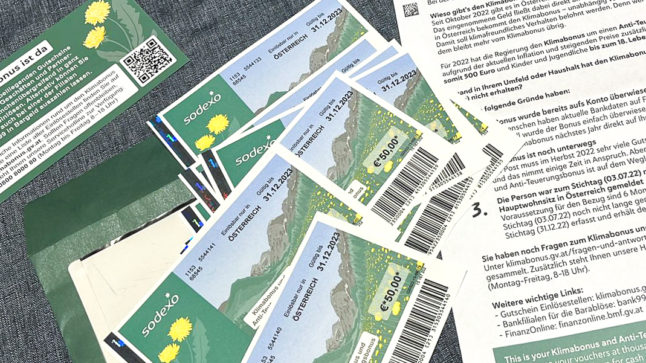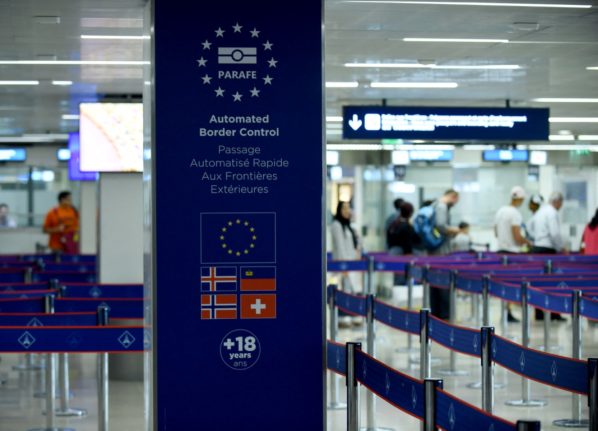With rising inflation, the Austrian government announced several measures to try and cushion the effects of higher cost of living for those who live in the country. One of the most talked about measures is the so-called Klimabonus (officially, the full name would be something like “the climate and anti-inflation bonus”), the €500 one-off payment that every resident in the country is entitled to.
The Klimabonus is supposed to be straightforward: no need to apply for it, no long queues, no different criteria or different amounts depending on income. However, there are two rules: the recipient must live in Austria for six months in 2022, and minors receive half the amount.
READ ALSO: Reader question: I’ve received my Austrian Klimabonus as a voucher, now what?
The “easy” payments would be sent directly to the recipient’s bank account registered with FinanzOnline – those who do not have their data up to date would instead get a secure letter with Klimabonus vouchers that can be exchanged for money or used in hundreds of stores and supermarkets.
It hasn’t been that simple, though, as payments started on September 1st and many people still haven’t received their money – despite the government saying the payments were complete by October 19th.
Here are some reasons why you might not have received your €500 payment yet.
READ ALSO: Why is Austria’s €500 climate bonus causing controversy?
You are not entitled to it
The first reason, of course, is if you are not entitled to the payment.
According to the federal government, “Everyone who has their main residence in Austria for at least 183 days in the year of entitlement receives the climate bonus – regardless of age or origin and citizenship.”
READ ALSO: Everything that changes in Austria in October 2022
This means you must have your primary residence for around six months in 2022 to receive the climate bonus this year. So if you moved this year and haven’t been here for that long, then you are not entitled to it – yet.
If you moved but are unregistered with the authorities here (in other words, you haven’t got your Meldezettel), then you are also not entitled.
You recently moved to Austria
Those who moved to Austria this year will also only get their payment next year. This is because the government uses the data from July 3rd to assess who has been in Austria for 183 days.
READ ALSO: Reader question: I recently moved to Austria, will I receive the ‘climate bonus’?
This means that if you moved in 2022 and have not been in Austria for 183 days on July 3rd, you’ll end up in the second payout round to be processed at the end of the year and paid in February 2023.
The same is valid for babies born this year in Austria. As these people won’t show up as living in Austria for 183 days as of July 3rd, they should get their payment (the total amount, referring to 2022) only in early 2023.

You are one of the last people to get it
(UPDATE: by October 19th, the federal government announced it had made all payments. If you are entitled to it already this year, you’re likely one of the unlucky ones (check below))
There is another reason why you might not have gotten your payment: you’re just last in line for this first payment. The transfers are made daily but capped to a – technical – limit and are made randomly.
According to the Linz IT company Programmierfabrik, which programmed the database behind the system, the payments are ongoing. Managing director Wilfried Seyruck said: “We have been making 300,000 transfers every day since September 5th.
“Therefore, it will take us 25 days until all 7.4 million claimants have received the transfer. We should be finished by the end of the first week of October.”
READ ALSO: EXPLAINED: What is the ‘Vollmacht Klimabonus 2022’ letter everyone in Austria is receiving?
So, if you are getting your payment through a wire transfer to your bank account, it might take a bit longer. However, it might take even longer if you don’t have your updated information with Austria’s FinanzOnline authorities.
As the government stated when they announced the bonus, those who don’t have their bank accounts up to date will receive a voucher instead. There are about 1.2 million people in Austria in that situation.
In these cases, it can take until the end of October to arrive by secure mail – and then people will have to trade the voucher for cash.
You got unlucky
We can’t rule out that there might have been an error in your case. The federal government said that, “in individual special cases, the payment transfer or delivery of the vouchers was not possible”.
“Our team is currently busy following up on these cases”, it added.
The government later in October also updated the information: “For some groups of EU citizens or third-country nationals, there are currently still some problems with the automated entitlement check by the Ministry of the Interior. Every effort is being taken to find a solution, please bear with us.”
READ ALSO: ‘I’m still waiting’: Foreigners in Austria still not been paid Klimabonus handout
They said: “You will receive your payment for 2022 in the second wave of payments starting February 2023.”
You can check your bank information on FinanzOnline to see if the data is up to date and correct. If you haven’t gotten your transfer or a voucher by the end of October, you can reach the Klimabonus service team on the phone.
The service is available in German, from Monday to Friday, from 8 am to 6 pm on 0800 8000 80.
As of mid-October, The Local has called the service and we were informed that people should still wait until the end of the month for their payments.



 Please whitelist us to continue reading.
Please whitelist us to continue reading.
Member comments